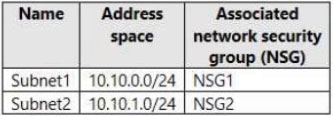HOTSPOT -
You have an Azure virtual network that contains the subnets shown in the following table.

In.NSG1, you create inbound rules as shown in the following table.

NSG2 has only the default rules configured.
You have the Azure virtual machines shown in the following table.

For each of the following statements, select Yes if the statement is true. Otherwise, select No.
NOTE: Each correct selection is worth one point.
Hot Area:

